SPLINTERS
Tennessee Valley Woodworkers
 Vol. 16/ Issue1
January 2001
Editor: Tom Gillard
Vol. 16/ Issue1
January 2001
Editor: Tom Gillard 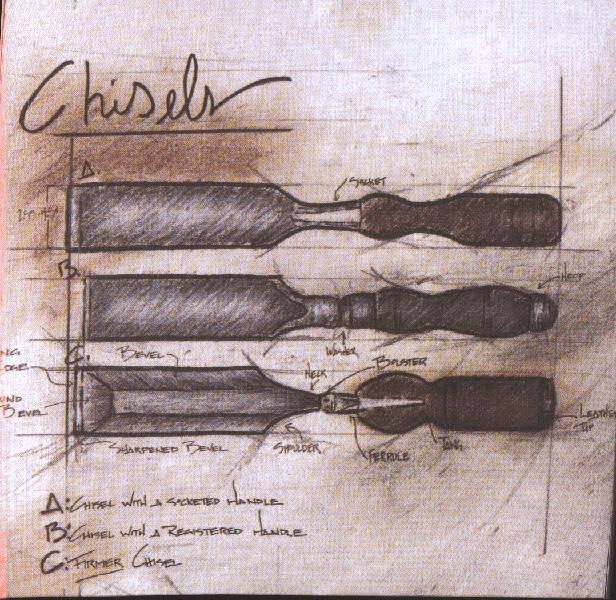

Meeting Notice:
The next meeting of the TN Valley Woodworkers
Will be held, January 16 at 7:00 p.m. in the
Duck River Electric Building, Decherd, TN
All interested woodworkers are invited!


The following people have agreed to serve as contacts for their particular
skills. If you have questions, suggestions for activities, or other
comments relating to these skills, please call these folks. Their
interest is to help the club better serve their area of expertise.
Your participation with them will help them achieve that goal.
Alice Berry 454-3815 Design
Phil Bishop 967-4626
Finishing
Tom Church 967-4460 Turning
Harry May 962-0215
Carving
Bob Reese 728-7974 Sharpening
Jim Van Cleave 455-8150 Jointery
Maurice Ryan 962-1555 Health and Safety

 HAPPY NEW YEAR!
HAPPY NEW YEAR! 
BUSERA The elephant tree
Although quite common throughout all of northern Mexico, what has
come to be called the elephant tree grows only in isolated areas of the
American Southwest and West. In fact, the tree’s whereabouts were
known only to adventurous prospectors and other desert rats until the early
1900’s. Then, a wandering scientist heard a tale concerning a strange
white-barked tree whit limbs like an elephant’s trunk and wood that bled
red when cut. Determined to find this tree, the scientist set out
into the desert of eastern San Diego County, California. Hear a place
called Split Mountain, he came upon the tree just as described. It
wasn’t until the late 1930’s though, that enough trees were found to credit
Busera microphylla as native to the U.S. Today, the elephant tree’s
range is known to extend along the coast of the Gulf of California in Mexico,
north to Arizona’s Gila Desert, and into the Imperial Valley of California.
The largest specimens in the US-20’ tall-grow in Arizona. Called
toroto or copal in Mexico, the strangely attractive trees yield a gum that
is used there as a base for varnish and a preservative for wood.
The gum also works as an adhesive. And the incense burned in Mexican
churches has its source in the wood of the elephant tree, a member of the
same botanical family that provided the frankincense mentioned in the Bible.
WOOD Aug-97 Issue #98
TENNESSEE VALLEY WOODWORKERS MINUTES
December 19, 2000
President Tom Cowan called the meeting to order at 7:00 P. M.
Welcomed guest were John Hawk, Julie and Bill Rose, daughter and son-in-law
of Phil and Shirley Bishop.
ANNOUNCEMENTS:
President Tom Cowan announced the appreciation of everyone coming to
the Christmas special meeting. In addition, Tom announced that notes by
Jim Deltoro and Barbara Keen on the finishing seminar were available. Tom
announced that Doyle McConnell’s mother had suffered a stroke.
Maurice Ryan passed out a pamphlet from Lowe’s in Tullahoma that offered
a 10% discount for a limited time and one time only on an item purchased
there. Offer expires January 15, 2001.
Ross Roepke passed out a list of tools and other items for sale by
Marilyn Lemming. The tools belonged to her husband, John who passed away
in September.
Loyd Ackerman announced that he is collecting the results of the survey
that was passed out in the November meeting which request input from members
as to their desires for future club activities or other suggestions.
Maurice Ryan passed out earplugs and suggested that everyone use them.
SHOW AND TELL
The December show and tell was a comparison of old and new items that
club members had made over the years.
Ken Gould-photo of an entertainment center that was use to build tables.
Also, picture of a rose arbor, coyote carving, and a frog carved from walnut
in 1993.
Loyd Ackerman-the first turning project consisted of a bowl from popular
and the second project was a walnut bowl. Later project was a vase made
of apple wood.
Henry Davis-old magazine rack made in 1953 and a book from Henry’s
High School woodworking teacher from Shelbyville, TN.
Tom Gillard-belt buckles, which were some of his first craft items.
Tom Cowan-jig saw bought for $24.95 in 1953 or 1954. Engraving tool
from his Father and Mother. Spinning wheel carving that was given to a
teacher and later returned to him by the teacher’s daughter after the teacher
passed away.
David Whyte-drawing table and router bit.
Ray Cole Pictures of an elaborate house that he is building on Tim’s
ford lake. He is doing all cabinets, doors and trim. The house has approximately
18,000 square feet and is four stories high.
Tom Church-small bowl, which was a first turning and a new large bowl
made of gingko wood. Very unique bowl.
Bob Reese-old whittled cedar chest for his wife and a recent made fiddle.
Phil Bishop-wooden train made in 1975, unique box with burl on top
and a finial.
Ross Roepke-table made while in high school and a picture of a table
being built.
Susan Church-box, inlaid plate, and vase.
Bob Leonard-carving of pig, quail, mushroom, cowboy boot, duck, bird
with snake and a chest made of walnut wood.
Jim Roy-chop board made of multiple wood and finished with mineral
oil. New biscuit joiner.
There were a total of 42 members and guest in attendance.
Respectfully submitted, John Mayberry, secretary
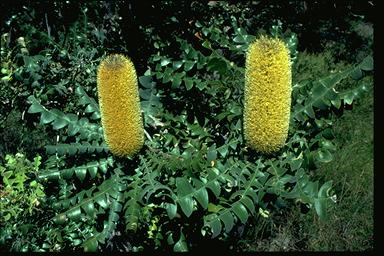
grandis
Bull Banksia/Giant Banksia
A native of Western Australia, it prefers light to medium soils in an
open, sunny position, and is drought resistant but frost tender. An evergreen
tree, it grows to a height of 8 m with a spread of 3 m. The stem is erect,
with rough, grey bark; the leaves are dark green, divided to midrib, and
40 cm long with triangular, overlapping segments; the flowers are spectacular
golden, cylindrical spikes, 40 cm long and 8 cm wide, erect and profuse,
appearing in spring. Propagation occurs readily by seed.
Now back in stock.
Named after Sir Joseph Banks (1743 –1820) who set sail with Captain
Cook on the Endeavour in1768. Many species of Banksia
grow in Australia, but only this one produces sufficiently large cones
for turning. Banksia
grandis has a very limited range in Western Australia as an under storey
tree in Jarrah forests (we also supply Jarrah bowl blanks). The cones
can take
several years to mature. Very different and unusual, these cones
are sliced into drinks coasters in Australia, jewellery and perfume bottles.
Flower arrangers sometimes use them in displays. Easily turned (they can
also be hollow turned) they are
best polished with oil ( waxes will get into the orifices and turn
white).
The minimum value of any order before postage and packing is £15.00.
Postage and packing is charged at a nominal value of £4.99 per order.
Dispatch will normally
be via three day assured delivery.
.
Put on Your Pads; Clamp Pads That Is
As you read this, you're probably thinking . . . "Won't this guy ever stop
with the polyurethane adhesive stuff ?" Once again the "Glueru" brings
a tip which may take some of the frustration from glue-ups in the shop
or on the job site.
The following tip will work for most any clamp, but is especially useful
for bar and pipe clamps which present large surfaces on the clamp
"faces". What results will be clamps with softer faces, which significantly
reduces the likelihood of marring of the workpieces.
1. Remove any grease, oil or other substance from the surface of the clamp
faces. Denatured alcohol, acetone or other quick evaporating solvent will
work fine for this step.
2. Cut wood pads to closely (doesn't have to be exact, we're not building
a piano) match the size and shape of the clamp faces. I use 1/4" pine plywood
scraps for my pads, but any wood should work fine as long as you keep in
mind that you are trying to eliminate marring of the workpiece and that
softer woods will serve better than harder woods. Clean or
wipe any dust from the pads.
3. Prepare to glue the pads to the metal clamp faces by deciding which
face of the pads will receive the adhesive. Lightly dampen the pads where
the adhesive is to be applied and apply just enough polyurethane adhesive
to cover the surface of the pads.
4. Position the clamp you are working with so that the clamping faces are
relatively close to each other and place a pad on each clamping face.
Be sure there is no residual adhesive on the face of the pads or you will
not be able to separate the clamp faces. Slide or otherwise adjust the
clamp faces so they are just touching and adjust the clamps so that the
pressure (face to face) is sufficient to hold the pads in place as the
adhesive cures.
The pads I have installed on all of my clamps using the above methods have
stayed put for more than two years. If any pads should become marred they
can be removed with an old chisel or similar tool, after which new pads
can be installed as before.
C.E. "Chuck" Ring
Hardblock to Happiness
The one thing I've seen in almost every professional woodshop aside from
tablesaws and compressors is what is commonly known as a"hardblock".
Invariably this is a small sanding belt tightly wrapped around an oblong
block made of wood, plywood, MDF, particleboard, MCP, acrylic, etc. One
guy even has his hardblocks made of walnut in a variety of grits.
The first thing you notice when you pick one of these things up is, "How
did they get these belts so tight?" After some inspection it becomes clear
the belts were wrapped loose, and then shims were forced in the ends between
the belt and the block. Personally, I like to use common nails. They are
inserted slowly between the belt and block-end with a hammer. Since the
belt is used until it's exhausted, removal of the shims is easy by just
tearing off the belt or slipping the nails out by their heads
For a 3X24 belt, you'll need a 1/2" block 11 3/8" long. Width can vary
depending on what you want your block for. 4" or larger is good for flattening
large surfaces while a 2" wide belt stays on a narrow edge. But you'll
get the idea after you make your first hardblock and put it to use.


Henry wants to remind everyone that DUES are due. You won’t find
a club with a more reasonable rate.
$10 for singles
$12 for families
THANK YOU
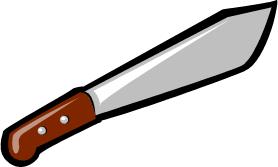
This meeting: Guest, Bob Lavine is going to show off some of
his knife masterpieces.
WEB SITES
of INTEREST
Arrowmont
School of Arts and Craft
WOOD
ONLINE newsletter
Falls Mill
Appalachain
Center for the Arts
Forest
Products Lab. 1999 Wood Handbook
Jim DelToro
Highland Hardware
Woodworker's
Journal
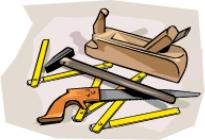
Don’ Miss this Event!!
February 2-4 The Nashville Woodworking
Show I-24 EXPO Center
Smyrna, TN Cost: $9.00
I’ve made a mistake and bought too many #20 biscuits. If anyone
needs some I’ll sell them for $5.00/100. I have about 500-600 to
sell. Tom Gillard

 Saw Blade Sharpening Services: Branching Out is now offering their
services as a drop off spot to have your saw blades sharpened. The
blades will be picked up (Tuesdays), sharpened, and dropped back off at
Branching Out. The Leitz Tooling Systems out of Collierville, TN
will do the sharpening. Call (393-0525) or stop by for details.
Saw Blade Sharpening Services: Branching Out is now offering their
services as a drop off spot to have your saw blades sharpened. The
blades will be picked up (Tuesdays), sharpened, and dropped back off at
Branching Out. The Leitz Tooling Systems out of Collierville, TN
will do the sharpening. Call (393-0525) or stop by for details.
FROM the GREENS
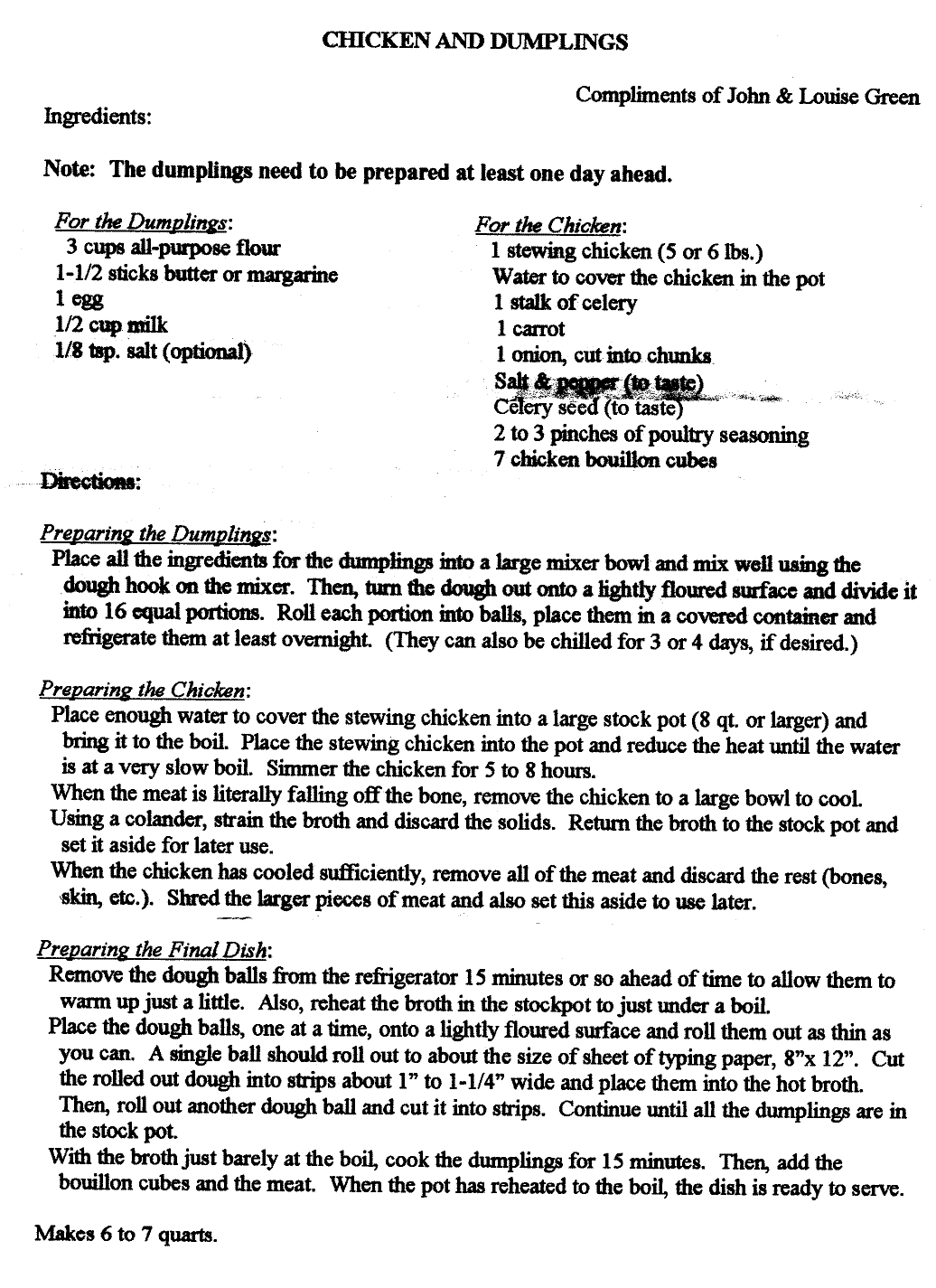
Right click on the these photos and 'save image'
then go to a viewer and insert them. You can print from this application.
Another recall

 Vol. 16/ Issue1
January 2001
Editor: Tom Gillard
Vol. 16/ Issue1
January 2001
Editor: Tom Gillard 
![]()
![]()
![]()
![]()
HAPPY NEW YEAR!


